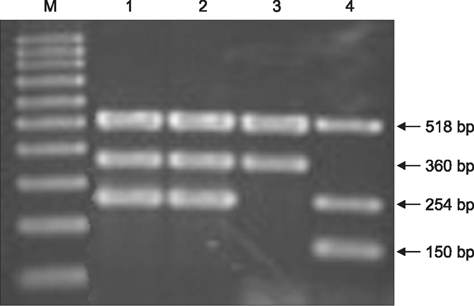J Vet Sci.
2016 Sep;17(3):427-429. 10.4142/jvs.2016.17.3.427.
Mycobacterium bovis infection in a wild sow (Sus scrofa): the first case in Korea
- Affiliations
-
- 1Animal Disease Control Center, Animal and Plant Quarantine Agency, Daegu 42768, Korea. kubk@korea.kr
- 2Bacterial Disease, Department of Animal and Plant Health Research, Animal and Plant Quarantine Agency, Gimcheon 39660, Korea.
- 3Department of Biomedical Laboratory Science, College of Health Science, Yonsei University, Wonju 26493, Korea. bojeon@yonsei.ac.kr
- 4Gyeongsangnam-do Livestock Veterinary Promotion Institute, Jinju 52733, Korea.
- 5Gyeongsangbuk-do Veterinary Service Laboratory, Daegu 41405, Korea.
- KMID: 2413145
- DOI: http://doi.org/10.4142/jvs.2016.17.3.427
Abstract
- Mycobacterium (M.) bovis causes tuberculosis and has a broad host range, including humans, livestock, and wild animals. M. bovis infection of wild boar has been reported in several European countries. We report here the first case of M. bovis infection in a domesticated wild sow in Korea. Granulomatous and necrotizing lesions with small numbers of acid-fast bacilli were observed in nodules of the lung of wild sow. Furthermore, the M. bovis isolate from the wild sow had spoligotype SB0140 and a novel MIRU-VNTR allelic profile, which is not found in cattle and deer in Korea.
Keyword
MeSH Terms
Figure
Reference
-
1. Barasona JA, Latham MC, Acevedo P, Armenteros JA, Latham ADM, Gortazar C, Carro F, Soriguer RC, Vicente J. Spatiotemporal interactions between wild boar and cattle: implications for cross-species disease transmission. Vet Res. 2014; 45:122.
Article2. Fitzgerald SD, Kaneene JB. Wildlife reservoirs of bovine tuberculosis worldwide: hosts, pathology, surveillance, and control. Vet Pathol. 2013; 50:488–499.
Article3. Je S, Ku BK, Jeon BY, Kim JM, Jung SC, Cho SN. Extent of Mycobacterium bovis transmission among animals of dairy and beef cattle and deer farms in South Korea determined by variable-number tandem repeats typing. Vet Microbiol. 2015; 176:274–281.
Article4. Jeon BY, Je S, Park J, Kim Y, Lee EG, Lee H, Seo S, Cho SN. Variable number tandem repeat analysis of Mycobacterium bovis isolates from Gyeonggi-do, Korea. J Vet Sci. 2008; 9:145–153.
Article5. Kim Y, Choi Y, Jeon BY, Jin H, Cho SN, Lee H. A simple and efficient multiplex PCR assay for the identification of Mycobacterium genus and Mycobacterium tuberculosis complex to the species level. Yonsei Med J. 2013; 54:1220–1226.
Article6. Naranjo V, Gortazar C, Vicente J, de la Fuente J. Evidence of the role of European wild boar as a reservoir of Mycobacterium tuberculosis complex. Vet Microbiol. 2008; 127:1–9.
Article7. Palmer MV. Mycobacterium bovis: characteristics of wildlife reservoir hosts. Transbound Emerg Dis. 2013; 60:Suppl 1. 1–13.
Article8. Pesciaroli M, Alvarez J, Boniotti MB, Cagiola M, Di Marco V, Marianelli C, Pacciarini M, Pasquali P. Tuberculosis in domestic animal species. Res Vet Sci. 2014; 97:Suppl. S78–S85.
Article9. Santos N, Correia-Neves M, Ghebremichael S, Källenius G, Svenson SB, Almeida V. Epidemiology of Mycobacterium bovis infection in wild boar (Sus scrofa) from Portugal. J Wildl Dis. 2009; 45:1048–1061.
Article
- Full Text Links
- Actions
-
Cited
- CITED
-
- Close
- Share
- Similar articles
-
- Cross-Reactivity of Porcine Immunoglobulin A Antibodies with Fecal Immunoglobulins of Wild Boar (Sus scrofa) and Other Animal Species
- Spargana in a Weasel, Mustela sibirica manchurica, and a Wild Boar, Sus scrofa, from Gangwon-do, Korea
- A survey of porcine reproductive and respiratory syndrome among wild boar populations in Korea
- Seroprevalence of Toxoplasma gondii Infection in Wild Boars, Wild Rabbits, and Wild Chickens in Hubei Province, China
- Differentiation between Mycobacterium bovis and Mycobacterium tuberculosis Infection



